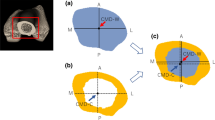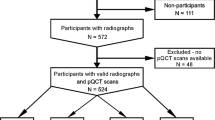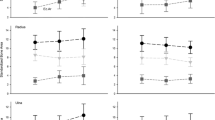Abstract
Bone geometry is an important determinant of bone strength and is influenced by muscle pull and weight-bearing. Muscle mass and exposure to weight-bearing decrease with age and thus the purpose of the study was to compare bone geometry of the weight-bearing (tibia) and non-weight-bearing (fibula) bones of the leg in different age groups. Magnetic resonance images of the right leg were acquired in 13 young (26 yr), 13 old (66 yr), and 13 very old men (83 yr). Cortical, medullary and total cross-sectional areas (CSA) of the bones were measured at approximately one-third and two-thirds the length of the leg. Muscle CSA of the anterior, lateral and posterior compartments was measured at the proximal site. Cortical CSA was ~14 to 22% smaller in the elderly in the tibia but similar across age in the fibula. Medullary CSA was larger with age (~5 to 65%) in both bones but ~15 to 440% greater in the tibia than fibula. Total CSA was similar across age in both bones. Muscle mass was similar between young and old but ~25% less in the very old and as a consequence, the magnitude of differences in bone geometry at proximal and distal sites varied in the two elderly groups. These findings indicate that there is a complex age-dependent interaction between muscle pull and weight-bearing. The greater age-related differences in bone geometry in the tibia suggest the weight-bearing role of the tibia makes it more susceptible than the fibula to the reduced activity typically associated with aging.

Similar content being viewed by others
References
Jiang HX, Majumdar SR, Dick DA, Moreau M, Raso J, Otto DD, Johnston DW (2005) Development and initial validation of a risk score for predicting in-hospital and 1-year mortality in patients with hip fractures. J Bone Miner Res 20:494–500
Smith EL, Tommerup L (1995) Exercise: a prevention and treatment for osteoporosis and injurious falls in the older adult. J Aging Phys Act 3:178–192
Gennari C, Seeman E (2001) The first international conference on osteoporosis in men. Siena, Italy, February 23–25, 2001. Calcif Tissue Int 69:177–178
Seeman E, Bianchi G, Adami S, Kanis J, Khosla S, Orwoll E (2004) Osteoporosis in men—consensus is premature. Calcif Tissue Int 75:120–122
Seeman E, Bianchi G, Khosla S, Kanis JA, Orwoll E (2006) Bone fragility in men—where are we? Osteoporos Int 17:1577–1583
Klein CS, Allman BL, Marsh GD, Rice CL (2002) Muscle size, strength, and bone geometry in the upper limbs of young and old men. J Gerontol A 57:M455–M459
McMillan SJ, Marsh GD (2002) Humeral and femoral shaft geometry in young and old men. Med Sci Sports Exerc 34:S59
Frost HM (1997) On our age-related bone loss: insights from a new paradigm. J Bone Miner Res 12:1539–1546
Riggs BL, Melton LJIII, Robb RA, Camp JJ, Atkinson EJ, Peterson JM, Rouleau PA, McCollough CH, Bouxsein ML, Khosla S (2004) Population-based study of age and sex differences in bone volumetric density, size, geometry, and structure at different skeletal sites. J Bone Miner Res 19:1945–1954
Ruff CB, Hayes WC (1988) Sex differences in age-related remodeling of the femur and tibia. J Orthop Res 6:886–896
Myers ER, Hecker AT, Rooks DS, Hipp JA, Hayes WC (1993) Geometric variables from DXA of the radius predict forearm fracture load in vitro. Calcif Tissue Int 52:199–204
Woodhead HJ, Kemp AF, Blimkie CJR, Briody JN, Duncan CS, Thompson M, Lam A, Howman-Giles R, Cowell CT (2001) Measurement of midfemoral shaft geometry: repeatability and accuracy using magnetic resonance imaging and dual-energy X-ray absorptiometry. J Bone Miner Res 16:2251–2259
Klein CS, Rice CL, Marsh GD (2001) Normalized force, activation, and coactivation in the arm muscles of young and old men. J Appl Physiol 91:1341–1349
Holmback AM, Askaner K, Holtas S, Downham D, Lexell J (2002) Assessment of contractile and noncontractile components in human skeletal muscle by magnetic resonance imaging. Muscle Nerve 25:251–258
Heinonen A, McKay HA, Whittall KP, Forster BB, Khan KM (2001) Muscle cross-sectional area is associated with specific site of bone in prepubertal girls: a quantitative magnetic resonance imaging study. Bone 29:388–392
Frost HM (2003) Bone’s mechanostat: a 2003 update. Anat Rec 275A:1081–1101
Daly RM, Bass SL (2006) Lifetime sport and leisure activity participation is associated with greater bone size, quality and strength in older men. Osteoporos Int 17:1258–1267
Mikkola TM, Sipila S, Rantanen T, Sievanen H, Suominen H, Kaprio J, Koskenvuo M, Kauppinen M, Heinonen A (2008) Genetic and environmental influence on structural strength of weight-bearing and non-weight-bearing bone: a twin study. J Bone Miner Res 23:492–498
Wang Q, Alen M, Nicholson P, Suominen H, Koistinen A, Kroger H, Cheng S (2007) Weight-bearing, muscle loading and bone mineral accrual in pubertal girls—a 2-year longitudinal study. Bone 40:1196–1202
Lindahl O, Lindgren AG (1967) Cortical bone in man. 1. Variation of the amount and density with age and sex. Acta Orthop Scand 38:133–140
Martin RB, Pickett JC, Zinaich S (1980) Studies of skeletal remodeling in aging men. Clin Orthop Relat Res 149:268–282
Takebe K, Nakagawa A, Minami H, Kanazawa H, Hirohata K (1984) Role of the fibula in weight-bearing. Clin Orthop Relat Res 184:289–292
Hamrick MW, Skedros JG, Pennington C, McNeil PL (2006) Increased osteogenic response to exercise in metaphyseal versus diaphyseal cortical bone. J Musculoskelet Neuronal Interact 6:258–263
Ruff CB, Hayes WC (1982) Subperiosteal expansion and cortical remodeling of the human femur and tibia with aging. Science 217:945–948
Russo CR, Lauretani F, Seeman E, Bartali B, Bandinelli S, Di Iorio A, Guralnik J, Ferrucci L (2006) Structural adaptations to bone loss in aging men and women. Bone 38:112–118
Ruff CB, Hayes WC (1984) Age changes in geometry and mineral content of the lower limb bones. Ann Biomed Eng 12:573–584
Kent-Braun JA, Ng AV (1999) Specific strength and voluntary muscle activation in young and elderly women and men. J Appl Physiol 87:22–29
Kent-Braun JA, Ng AV, Young K (2000) Skeletal muscle contractile and noncontractile components in young and older women and men. J Appl Physiol 88:662–668
McNeil CJ, Vandervoort AA, Rice CL (2007) Peripheral impairments cause a progressive age-related loss of strength and velocity-dependent power in the dorsiflexors. J Appl Physiol 102:1962–1968
Morse CI, Thom JM, Davis MG, Fox KR, Birch KM, Narici MV (2004) Reduced plantarflexor specific torque in the elderly is associated with a lower activation capacity. Eur J Appl Physiol 92:219–226
Morse CI, Thom JM, Reeves ND, Birch KM, Narici MV (2005) In vivo physiological cross-sectional area and specific force are reduced in the gastrocnemius of elderly men. J Appl Physiol 99:1050–1055
Simoneau E, Martin A, Van Hoecke J (2005) Muscular performances at the ankle joint in young and elderly men. J Gerontol A 60:439–447
Winegard KJ, Hicks AL, Sale DG, Vandervoort AA (1996) A 12-year follow-up study of ankle muscle function in older adults. J Gerontol A 51:B202–B207
Lexell J, Taylor CC, Sjostrom M (1988) What is the cause of ageing atrophy? Total number, size and proportion of different fiber types studied in whole vastus lateralis muscle from 15- to 83-year-old men. J Neurol Sci 84:275–294
Johnson MA, Polgar J, Weightman D, Appleton D (1973) Data on the distribution of fibre types in thirty-six human muscles. An autopsy study. J Neurol Sci 18:111–129
Christ CB, Boileau RA, Slaughter MH, Stillman RJ, Cameron JA, Massey BH (1992) Maximal voluntary isometric force production characteristics of six muscle groups in women aged 25 to 74 years. Am J Hum Biol 4:537–545
Rantalainen T, Heinonen A, Komi PV, Linnamo V (2008) Neuromuscular performance and bone structural characteristics in young healthy men and women. Eur J Appl Physiol 102:215–222
Melton LJIII, Riggs BL, Achenbach SJ, Amin S, Camp JJ, Rouleau PA, Robb RA, Oberg AL, Khosla S (2006) Does reduced skeletal loading account for age-related bone loss? J Bone Miner Res 21:1847–1855
Acknowledgements
This work is supported in part by the National Sciences and Engineering Research Council of Canada (NSERC) and the Canadian Institutes of Health Research (CIHR).
Author information
Authors and Affiliations
Corresponding author
Rights and permissions
About this article
Cite this article
McNeil, C.J., Raymer, G.H., Doherty, T.J. et al. Geometry of a Weight-Bearing and Non-Weight-Bearing Bone in the Legs of Young, Old, and Very Old Men. Calcif Tissue Int 85, 22–30 (2009). https://doi.org/10.1007/s00223-009-9261-7
Received:
Accepted:
Published:
Issue Date:
DOI: https://doi.org/10.1007/s00223-009-9261-7




